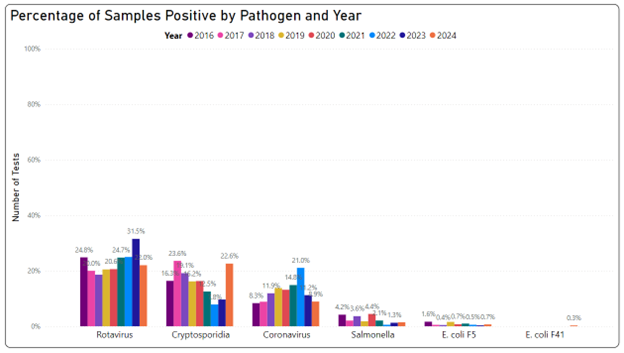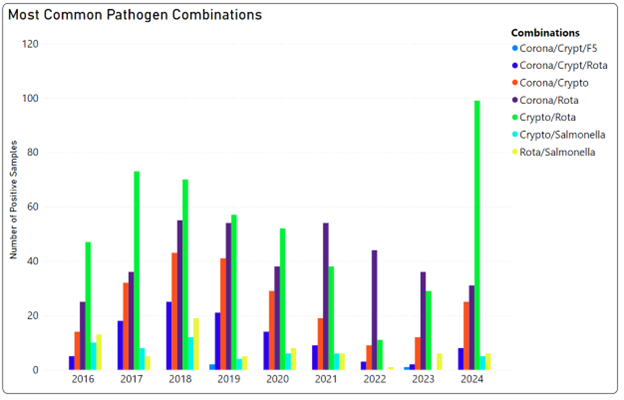
January 2025
Bovine Neonatal Diarrhea PCR Results: 2016-2024
By Dr. Gregg A. Hanzlicek
The percentage of samples containing each pathogen over the last nine years is shown in the first graph below. Rotavirus for the previous seven years was found in an increasing number of samples, Interestingly, in 2024 there was a 10% decrease in rotavirus positive samples. The percentage of coronavirus positive samples decreased for the second year in a row. In contrast, that the percentage of cryptosporidia positive samples increased by more than 10% over the last year. Our PCR test has not been modified, so this may indicate there may have been a shift in pathogen prevalence in diarrhea cases submitted to our KVDL. The percentage of salmonella and E. coli positive samples has remained low at 1.0% or less for the last three years. We believe salmonella diarrhea issues are not common, and unlike the other pathogens it is not likely to be present on every operation.
Both pathogenic E. coli strains continue to be identified at a very low level. (We only started targeting E. coli F41 this year.) E. coli F5 is new name for E. coli K99. There a couple of reasons why positive samples remain at a low level. The PCR might not be as sensitive for E. coli as it is for the viruses and crypto. The other plausible explanation is that practitioners, understanding that early neonatal diarrhea is likely associated with only E. coli, do not often submit samples from that age demographic. For diarrhea workups from calves less than 6-7 days of age, we recommend that an aerobic culture for E. coli be performed followed with genotyping to identify the pili and toxins that might be present in these early cases.

Many samples from calves 10 days of age and older possess more than one pathogen. The graph below highlights the most common pathogen combinations. The most common combinations contain two pathogens; three and four-way combinations are much less common.
This visual is expressed a little bit differently than the graph above as these are counts, not percentages. Crypto/rotavirus and coronavirus/crypto combinations has been decreasing since 2018. In 2024 there was large increase in the number of positive samples containing these two combinations, green and orange lines, respectively. Although the number of samples containing rotavirus and coronavirus have recently decreased (as indicated in the graph above), cryptosporidia positive cases during the same period increased.

It is unlikely samples submitted to KVDL each year would represent the same calf population; therefore, drawing many conclusions from the trends is not possible. This summary does highlight the value of completing diagnostics in neonatal diarrhea outbreak cases to determine the associated pathogens as it is possible that pathogen populations are dynamic.
Next: KVDL's New and Improved App is Now Available!
Return to Index